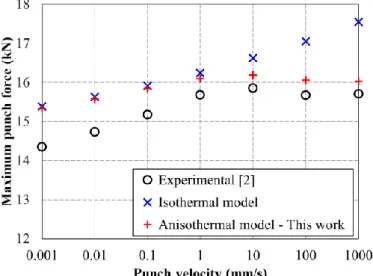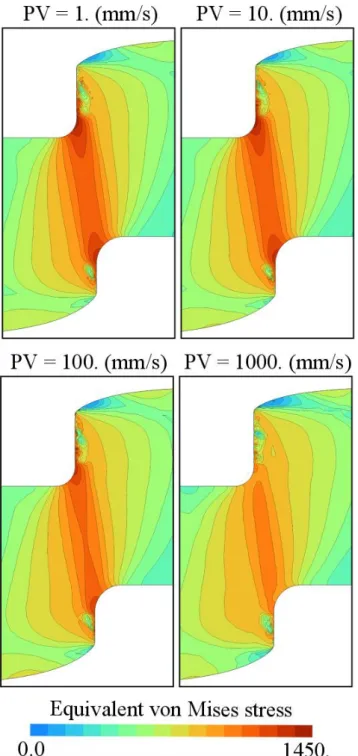Journal of Physics: Conference Series
PAPER • OPEN ACCESS
Thermomechanical simulations of blanking
process operated over a wide range of punch
velocities
To cite this article: Cristian Canales et al 2018 J. Phys.: Conf. Ser. 1063 012014
View the article online for updates and enhancements.
Related content
Influence of Clearance and Punch Velocity on the Quality of Pure Thin Copper Sheets Blanked Parts
Didin Zakariya Lubis and Muslim Mahardika
-Numerical model for a quantitative estimation of sliver formation in shearing process
Ramya Selvaraj, Luca Quagliato, Sewon Jang et al.
-Study on the deterioration origin of thermomechanical contact fatigue
O F Tudose-Sandu-Ville
1234567890 ‘’“”
NUMISHEET2018 IOP Publishing
IOP Conf. Series: Journal of Physics: Conf. Series 1063 (2018) 012014 doi :10.1088/1742-6596/1063/1/012014
Thermomechanical simulations of blanking process operated
over a wide range of punch velocities
Cristian Canales, Romain Boman & Jean-Philippe Ponthot
Liège University, Aerospace and Mechanical Engineering Department, Allée de la Découverte 13a, B4000 Liège, BelgiumT
JP.Ponthot@uliege.be
Abstract. A numerical model based on the finite element method has been developed
to simulate the blanking process. Thanks to this model we analyse the influence of punch velocities during blanking on the quality of the sheared edge and the characteristic parameters governing the process (maximum punch force and displacement, temperature increase). In this model, inertia, viscous and thermal effects are properly considered by means of a unified thermomechanical framework. A full remeshing approach is adopted to overcome the high distortion of elements due to large deformations, prior to fracture. The material strain-rate sensitivity is introduced by means of an extension of elasto-viscoplastic constitutive equations for the large strain regime. The inertial effects are considered thanks to an implicit time integration scheme. Crack propagation during the process is tracked using the element deletion method driven by an uncoupled damage criterion. Finally, the coupled thermomechanical problem is solved by an isothermal staggered scheme. Experimental and numerical results are compared for the entire range of punch velocities under consideration. Good agreement between both results has been found.
1. Introduction
The blanking process is nowadays broadly used in sheet metal forming, especially in the automotive and electronic industries. Due to the complexity of this technique, the set-up of the process in practice is often driven by empirical knowledge. Furthermore, the increasing demand of faster production lines in standardized industries has forced manufacturers to boost the operation velocity of the involved manufacturing methods. This increase in the operation velocity can induce additional inertia, viscous and thermal effects into the cutting process, affecting the final shape of the sheared edge and thus the quality of the final product. Numerical modeling arises as a useful tool able to accurately quantify the impact of all these phenomena and to optimize the entire process, avoiding the inefficient trial-and-error approach.
The present work aims at studying the influence of high-velocity operations in the blanking process by means of a coupled thermomechanical model based on the finite element method. This approach takes into account large strains, frictional contact interactions, potential inertial effects, material
strain-2
1234567890 ‘’“”
NUMISHEET2018 IOP Publishing
IOP Conf. Series: Journal of Physics: Conf. Series 1063 (2018) 012014 doi :10.1088/1742-6596/1063/1/012014
rate and thermal sensitivity in a unified way. Finally, the computed numerical results are compared with experimental results available in the literature.
2. Procedures, results and discussion
In this work, the constitutive equations are integrated considering a hypoelastic formulation, where the total strain rate D is decomposed as the sum of an elastic part De, an inelastic part Dvp and a thermal part Dth. Then, a Perzyna-type viscoplastic model is considered, which leads to a rate-dependent extension of the classical von Mises yield criterion. The infinitesimal definition of the thermal strain tensor is directly extended in order to model the evolution of the thermal part of D. The contact interactions are modeled by means of the node-to-surface scheme adopting an extension of the area regularization approach. The associated contact constraints are imposed thanks to the penalty method. A global remeshing-transfer procedure is performed during the simulations in order to prevent the mesh deterioration. The remeshing steps are automatically carried out when the distortion of a finite element reaches a critical value. The set of constitutive equations are integrated in time by means of the classical return mapping algorithm. In order to take into account potential inertia effects, an unconditionally stable implicit algorithm (i.e. the generalized-α method) is used to integrate the equations of momentum conservation. Finally, the coupled thermomechanical problem is solved by an isothermal staggered scheme, where a generalized mid-point method is used to integrate the heat equation as done by Adam and Ponthot [1].
The experimental axisymmetric set-up used in Goijaerts et al. [2] is reproduced to evaluate the predictive capabilities of the proposed approach. The material of the sheet corresponds to a ferritic stainless steel of 1 mm thickness. The constitutive behavior is emulated by a thermo-viscoplastic model with linear thermal softening of the hardening parameters. The clearance between the punch and the die is fixed to 0.1 mm. The geometry is discretized with classical Q4 axisymmetric elements with constant pressure. The range of punch velocities investigated here is between 0.001 mm/s and 1000 mm/s. The element deletion method is used to model crack propagation, which is driven by a phenomenological uncoupled damage model.
The effect of the punch velocity in the maximum punch force during blanking is represented in figure 1. The results of the proposed thermomechanical approach (anisothermal) are compared with those previously obtained with a purely mechanical framework (isothermal) by Canales et al. [3]. For punch velocities up to 1 mm/s the results between both models are very similar to each other. On the contrary, a large difference is found for punch velocities above 1 mm/s, where the maximum variation (9.5%) between the models was obtained for punch velocity=1000 mm/s. The numerical predictions of the proposed approach are in good agreement with the experimental results.
1234567890 ‘’“”
NUMISHEET2018 IOP Publishing
IOP Conf. Series: Journal of Physics: Conf. Series 1063 (2018) 012014 doi :10.1088/1742-6596/1063/1/012014
In figure 2, the contour of the equivalent von Mises stress for different punch velocities is shown. As expected, the stresses are concentrated in a narrow area delimited by the clearance (shearing zone). It can be noticed that the intensity of the stress field is affected by the punch velocity due to thermal softening, becoming more evident for punch velocity=100 mm/s and punch velocity =1000 mm/s. These results are attributed to a significant increase in temperature as consequence of applying larger punch velocities.
4
1234567890 ‘’“”
NUMISHEET2018 IOP Publishing
IOP Conf. Series: Journal of Physics: Conf. Series 1063 (2018) 012014 doi :10.1088/1742-6596/1063/1/012014
Figure 3 shows the evolution of maximum temperature variation during the process for different punch velocities. A clear tendency is here captured: higher temperature variations are obtained for larger values of punch velocities. The maximum increase of temperature (380 K) was obtained close to the minor radius of the punch for the largest punch velocity considered in this work.
Figure 3. Maximum temperature variation for different punch velocities.
3. Conclusions
The influence of high punch velocities in blanking has been successfully simulated and the relevance of considering viscous and thermal effects under these conditions has been demonstrated. Furthermore, the accuracy of the proposed framework has been verified with experimental results, validating its predictive capabilities
4. Acknowledgment
Cristian Canales would like to thank the FRIA-FNRS fund for its financial support.
References
[1] Adam, L., and Ponthot, J.-P., “Thermomechanical modeling of metals at finite strains: First and mixed order finite elements”, Int. J. Solids Structures (2005) 42, 5615.
[2] Goijaerts, A.M., Govaert, L.E., and Baaijens, F.P.T., “Experimental and numerical investigation on the influence of process speed on the blanking process”, J. Manuf. Sci. Eng. (2002)
124, 416.
[3] Canales, C., Bussetta, P., and Ponthot, J.-P., “On the numerical simulation of sheet metal blanking process”, Int. J. Material Forming (2017) 10, 55.


